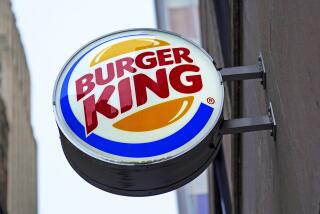‘Meet-or-Beat’ Ads Not All That They Promise
- Share via
Impressed by the well-advertised promise that a big electronics chain would “meet any price in town!” a Los Angeles couple priced the chain’s $1,257 Sony video camera at a nearby discount store. It was $987, $270 less, so they went back and asked the chain store’s manager if he’d meet the price, as promised.
Well, he said, customers have to verify the price and the fact that the store was an authorized Sony dealer. Then he consulted an inventory book, exclaimed “That’s below our cost!” and announced that he couldn’t possibly match the $987--despite store banners, newspaper ads and flyers promising “GUARANTEED LOW PRICES.” His best offer was $1,035.
This didn’t sit well with the couple, so they called the chain’s headquarters to ask what they’d misunderstood. Nothing, said an executive: The store would meet the price and even do the verifying; employees checked that particular discounter all the time.
So-called meet-or-beat advertising is popular now, particularly in consumer electronics, where everybody has the same products and brands, and the goods are luxuries, relatively costly and infrequently replaced. More sophisticated than the old “we won’t be undersold” gambit, today’s ads urge customers to buy now and skip price-shopping; if they find a lower price elsewhere within 30 days, they can come back for a refund, plus another 10% or 20% of the difference.
This seems good for consumers on two counts. The implication--indeed, “guarantee”--is that the retailer’s prices are low across the board, and the promised refund covers any exception. “I’d assume their prices are the lowest in town,” a stereo shopper says, “because it costs them money if they’re proved wrong.”
A Basic Assumption
It’s even better for the store because, thanks to the first assurance, they’re rarely called on the second. Indeed, says Guy Wirsig, director of operations for the Better Business Bureau in Los Angeles, “meet-or-beat advertising is usually done on the assumption that the customer won’t check and compare.”
Unfortunately, stores can also run such campaigns in lieu of having low prices. At the large chain store above, a number of products were priced higher than at other local discounters--from $50 higher on a low-priced videocassette recorder to $500 on a Sony SuperBeta. Nor was it always a mistake: The video camera above was still $1,257 three weeks after the store knew it cost less elsewhere.
“If stores know they’re not generally the lowest,” says Herschel Elkins, California’s senior assistant attorney general, “the implication that they are is, to a degree, lawsuit material--unless they’ve just goofed on a couple of items. You assume a reasonable attempt to be the lowest.”
As for the meet-or-beat promise, says Elkins, “if they don’t honor it, the ad is clearly a misrepresentation.” This isn’t unknown: Some stores, says Tim Bissell, chief investigator for the Los Angeles Consumer Affairs department, “always try to wiggle out of it.”
There may be valid reasons. The consumer may have found something with a slightly different model number, or with the same brand name and model number but cheaper because it’s “gray market”--goods made for a foreign market and imported to the U.S. by unauthorized channels of distribution.
Less Persuasive Excuses
There are many less persuasive excuses. “The typical cop-out,” Wirsig says, “is to say the competitive price wasn’t ‘advertised,’ though ‘advertised’ usually means any representation with the intent to sell.” Some stores speak of meeting any advertised price but instruct consumers to bring in a published ad as proof.
One vendor acknowledges that an “advertised” price could also be a tag on the merchandise or a sign in the window. Whatever, “if we can prove it’s true, we’d meet it,” he says.
But what constitutes proof? It could be a sales slip or contract. It could also be a signed note--perhaps on the competitor’s letterhead, suggests a salesman--confirming their given price and its effective time period.
But proof is the last step; a consumer may never get that far. Spot checks at several such stores met some categorical refusals to meet lower prices when the competing price was an “in-store special,” when the competitor was “a scam organization, not legitimate” or when the other store allows no returns or “doesn’t reflect market prices.” One salesman scoffed that the price was just too low to meet: “We do it if it’s profitable. It’s at our discretion.”
In each case, the customer could probably have fought further and higher and won, but “if one has to go through that much to get them to honor these guarantees,” a California lawyer says, “it’s easier to give up.” Comments one store executive: “Salesmen are salesmen. They always try to get the best they can for themselves,” and the store can only tell them to honor the policy and reprimand them if a consumer complains that they don’t.
Still, Elkins says, “a company should know at least as much about their operations as we do. They’re responsible for checking on what their agents are doing.”
More to Read
Inside the business of entertainment
The Wide Shot brings you news, analysis and insights on everything from streaming wars to production — and what it all means for the future.
You may occasionally receive promotional content from the Los Angeles Times.










